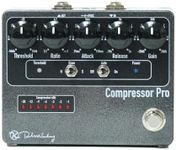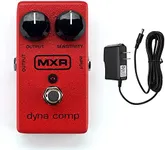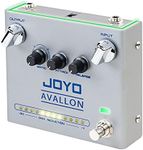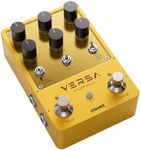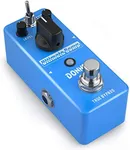Buying Guide for the Best Compressor Pedals
Choosing the right compressor pedal for your guitar can significantly enhance your sound by evening out the dynamics and adding sustain. A compressor pedal can help you achieve a more polished and professional tone, whether you're playing live or recording in the studio. To find the best fit for you, it's important to understand the key specifications and how they align with your playing style and needs.Compression RatioThe compression ratio determines how much the signal is compressed. A higher ratio means more compression, which can smooth out your playing and add sustain, but too much can squash your tone. Ratios typically range from 2:1 to 10:1. For subtle compression, a lower ratio (2:1 to 4:1) is ideal, while higher ratios (5:1 to 10:1) are better for more pronounced effects. Choose a ratio based on how much you want to control your dynamics.
Attack and ReleaseAttack and release settings control how quickly the compressor responds to your playing. Attack is the time it takes for the compressor to kick in after a note is played, and release is how long it takes to stop compressing after the note ends. Fast attack times can catch quick peaks, while slower attack times let more of the initial note through. Similarly, fast release times can make the compression more noticeable, while slower release times provide a smoother sound. Adjust these settings based on whether you want a more transparent or a more pronounced compression effect.
ThresholdThe threshold is the level at which the compressor starts to work. Signals above this level are compressed, while those below it are unaffected. A lower threshold means more of your signal will be compressed, which can be useful for evening out your playing. A higher threshold will only compress the loudest parts of your signal, preserving more of your natural dynamics. Choose a threshold setting based on how much of your playing you want to be affected by the compression.
SustainSustain controls how long the notes are held after being played. More sustain can make your notes ring out longer, which is great for solos and lead playing. Less sustain will give you a more natural decay. If you play a lot of lead guitar or want your notes to sing, look for a pedal with a good sustain feature. If you prefer a more natural sound, less sustain might be better.
Tone ControlSome compressor pedals come with a tone control, which allows you to adjust the brightness or darkness of your compressed signal. This can help you maintain clarity and presence in your sound, especially if the compression is affecting your tone. If you find that compression is dulling your sound, a tone control can help you dial back in some of the lost frequencies. Choose a pedal with tone control if you want more flexibility in shaping your sound.
True BypassTrue bypass means that when the pedal is turned off, your signal passes through without any alteration. This is important for maintaining the integrity of your tone when the pedal is not in use. If you have a lot of pedals in your signal chain, true bypass can help prevent tone loss. Look for a compressor pedal with true bypass if you want to ensure your signal remains clean and unaltered when the pedal is off.




